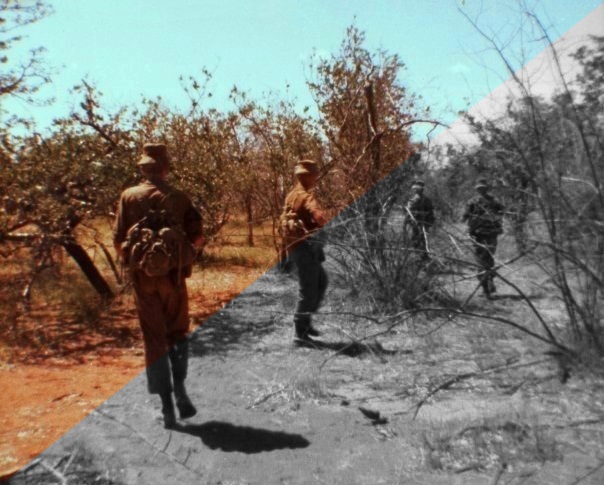低強度紛争
Low Intensity Conflict, LIC


解説:池田光穂
低強度紛争
Low Intensity Conflict, LIC
解説:池田光穂
強度を低レベルに抑えた戦争状況、あるいは戦争遂行理論のこと。対ゲリラ戦略に対して、代替する広範囲にわたる戦略として考案されたもの。低水
準紛争とも言う。
A
low-intensity conflict (LIC) is a military conflict, usually
localised, between two or more state or non-state groups which is below
the intensity of conventional war. It involves the state's use of
military forces applied selectively and with restraint to enforce
compliance with its policies or objectives.
米国を例にとると、包囲された特定の地域内(ニカラグア)を、経済的・政治的に破綻させるために、メディア(反共ラジオ放送)、外交政策 (周辺諸国への政治的経済的支援)、国際経済政策(ニカラグアの輸出産品にたいする国際価格の操作=下落)外交的介入(国外での反共的な臨時政府樹立を支 援、承認)など、直接行動(軍事介入)ではなく、間接的に対象地域を不安定にし、対象地域を制圧(臨時政府によるサンディニスタ政府の代替)する方法。
直接的な軍事介入をするのではなく、長期的な展望に立って、作戦行動を有機的に関連させる戦略である。したがって、この作戦の遂行には、個
々の戦術の、(1)時間的余裕、(2)長期的展望、(3)多極的でかつ有機的連関が不可欠とされる。この要素が欠けると、戦略は遂行側の時間的焦燥感、目
的の忘却、戦術の自己目的化、などによる意欲喪失が問題化され、戦略は失敗する。(狐崎知己氏の教示にもとづく)
加藤朗によると、1985年のレーガン政権のアフガニスタン反政府ゲリラへの援助以降、低強度紛争(LIC)は、内乱鎮圧のタイプから内乱
煽動へとその戦術が変化したという。というのは、旧ソ連が植民地からの独立をもとめて民族解放闘争(national
liberation)を支援してきたが、長期的な冷戦構造の結果、今度は米国がソ連の援助を受けて成立した政府に対する反政府抗争を支援するようなった
という。
「この内乱鎮圧から内乱煽動への戦術転換によって、援助の性格がきわめてイデオロギー的、あるいは軍事的色彩の濃いものになり、しかも秘密 工作による援助が多くなった。その端的な例が中米と中東を結ぶイラン・コントラ事件である。」(加藤朗『現代戦争論』中公新書,1993:109)
| 対反乱
counterinsurgency |
「転覆的反乱を鎮圧するために、[政府に
よってとられる]軍事的、準軍事的、政治的、経済的、心理的、および市民的活動」(p.88) |
| 対ゲリラ戦
counterguerrilla warfare |
「ゲリラに対し、軍隊、準軍事部隊または
[政府の]非軍事的機関よって行われる作戦と活動」(p.88) |
●LICを定義する3つの軍事的要素(low-intensity conflict (LIC) より)
1)武器
2)インテリジェンス
3)段階論(戦闘の——)
Weapons
As the name suggests, in comparison with conventional operations the armed forces involved operate at a greatly reduced tempo, with fewer soldiers, a reduced range of tactical equipment and limited scope to operate in a military manner. For example, the use of air power, pivotal in modern warfare, is often relegated to transport and surveillance, or used only by the dominant side of conflict in asymmetric warfare such as a government forces against insurgents. Artillery and multiple rocket launchers are often not used when LIC occurs in populated areas. The role of the armed forces is dependent on the stage of the insurrection, whether it has progressed to armed struggle or is in an early stage of propaganda and protests. Improvised explosive devices are commonly used by insurgents, militias and sometimes government forces such as barrel bombs[4] in low intensity conflicts.[5][6][7][8] The majority of casualties in low intensity conflicts tend to be resulting from small arms and improvised explosive devices.[7]
その名の通り、通常作戦に比べ、参加する軍隊は大幅にテンポを落と し、兵士の数も少なく、戦術的な装備の種類も少なく、軍事的に活動できる範囲も限定されている。例えば、現代戦の要である航空戦力は、輸送と監視に限定さ れるか、政府軍と反乱軍のような非対称戦では、紛争を支配する側のみが使用することが多い。人口密集地でLICが発生した場合、大砲や多連装ロケットラン チャーは使われないことが多い。武装勢力の役割は、反乱が武力闘争に進展しているか、プロパガンダや抗議の初期段階にあるかといった段階に左右される。低 強度紛争では、反乱軍や民兵、時には政府軍によって、樽爆弾のような即席の爆発物がよく使われる。低強度の紛争における死傷者の大半は、小火器や即席爆発 装置によるものである傾向がある(https://www.deepl.com/ja/translator による以下同様)
Intelligence
Intelligence gathering is essential to an efficient basis of LIC operation instructions. Electronic and signal gathering intelligence, ELINT and SIGINT, proves largely ineffective against low-intensity opponents. LIC generally requires more hands-on HUMINT methods of information retrieval.
低水準紛争の運用指示を効率的に行うためには、情報収集が不可欠で ある。電子情報諜報=ELINT(Electronic signals intelligence)や信号諜報=SIGINT(Signals intelligence)といった電子・信号収集情報は、低強度の相手にはほとんど効果がないことが分かっている。LIC では一般に、より実践的な 人間によるHUMINT(Human intelligence) による情報収集法が必要となる。
Stages
In the first stages of insurrection, much of an army's work is "soft" – working in conjunction with civil authorities in psychological operations, propaganda, counter-organizing, so-called "hearts and minds." If the conflict progresses, possibly into armed clashes, the role develops with the addition of the identification and removal of the armed groups – but again, at a low level, in communities rather than throughout entire cities.
反乱の最初の段階では、軍隊の仕事の多くは「ソフト」なもので、市 民当局と連携して心理作戦、宣伝、対組織、いわゆる「ハート・アンド・マインズ」に取り組む。紛争が進行し、場合によっては武力衝突に至ると、軍隊の役割 は武装集団の特定と排除が加わるが、これもまた、都市全体ではなく、地域社会における低レベルのものである。
A United States Marine asks a local woman about weapons in Fallujah, Iraq/ RAF Menwith Hill, a large site in the United Kingdom, part of ECHELON and the UKUSA Agreement, 2005
Electronic signals intelligence Electronic signals intelligence (ELINT) refers to intelligence-gathering by use of electronic sensors. Its primary focus lies on non-communications signals intelligence. The Joint Chiefs of Staff define it as "Technical and geolocation intelligence derived from foreign noncommunications electromagnetic radiations emanating from sources other than nuclear detonations or radioactive sources."[16] Signal identification is performed by analyzing the collected parameters of a specific signal, and either matching it to known criteria, or recording it as a possible new emitter. ELINT data are usually highly classified, and are protected as such. The data gathered are typically pertinent to the electronics of an opponent's defense network, especially the electronic parts such as radars, surface-to-air missile systems, aircraft, etc. ELINT can be used to detect ships and aircraft by their radar and other electromagnetic radiation; commanders have to make choices between not using radar (EMCON), intermittently using it, or using it and expecting to avoid defenses. ELINT can be collected from ground stations near the opponent's territory, ships off their coast, aircraft near or in their airspace, or by satellite.
電 子シグナル情報(ELINT)とは、電子センサーを利用した情報収集のことである。通信以外の信号情報に主眼が置かれている。統合参謀本部はこれを「核爆 発や放射性物質以外の発生源から発せられる外国の非通信電磁波から得られる技術的および地理的情報」と定義している。信号の識別は、特定の信号の収集パラ メータを分析し、既知の基準と照合するか、新しい放射源の可能性として記録することによって行われる。ELINTデータは通常、高度に機密化されており、 そのように保護されている。収集されたデータは、通常、相手の防衛ネットワークの電子機器、特にレーダー、地対空ミサイルシステム、航空機などの電子部品 に関連している。ELINT は、レーダーやその他の電磁波によって船舶や航空機を探知するために使用される。指揮官は、レーダーを使用しない(EMCON)か、断続的に使用するか、 使用して防衛を回避することを期待するかの選択を迫られることになる。ELINTは、相手の領域近くの地上局、相手の沿岸の船舶、相手の領空付近または領 空内の航空機、または衛星から収集することができる
Signals intelligence Signals intelligence (SIGINT) is intelligence-gathering by interception of signals, whether communications between people (communications intelligence—abbreviated to COMINT) or from electronic signals not directly used in communication (electronic intelligence—abbreviated to ELINT). Signals intelligence is a subset of intelligence collection management. As classified and sensitive information is usually encrypted, signals intelligence in turn involves the use of cryptanalysis to decipher the messages. Traffic analysis—the study of who is signaling whom and in what quantity—is also used to integrate information again.
信 号情報(シギント)とは、人と人との通信(通信情報:COMINTと略す)、または通信に直接使用されない電子信号(電子情報:ELINTと略す)の傍受 による情報収集のことである。シグナルズインテリジェンスは、情報収集管理の一部である。機密情報は通常、暗号化されているため、信号情報は暗号解読を必 要とする。また、トラフィック分析(誰が誰にどれだけの信号を送っているかの研究)も、情報を再び統合するために用いられる
Human intelligence (intelligence gathering)
Human intelligence (abbreviated HUMINT and pronounced as hyoo-mint) is intelligence gathered by means of interpersonal contact, as opposed to the more technical intelligence gathering disciplines such as signals intelligence (SIGINT), imagery intelligence (IMINT) and measurement and signature intelligence (MASINT).[1] NATO defines HUMINT as "a category of intelligence derived from information collected and provided by human sources."[1] HUMINT, as the name suggests, is mostly done by people rather than any technical means, and is commonly provided by covert agents and spies. For instance, Oleg Penkovsky was a Soviet military intelligence (GRU) colonel who served as a source to the UK and the United States by informing them of the precise knowledge necessary to address rapidly developing military tensions with the Soviet Union. A typical HUMINT activity consists of interrogations and conversations with persons having access to information. The manner in which HUMINT operations are conducted is dictated by both official protocol and the nature of the source of the information. Within the context of the U.S. military, HUMINT activity may involve clandestine activities, however these operations are more closely associated with CIA projects.[2] Both counter intelligence and HUMINT include clandestine HUMINT and clandestine HUMINT operational techniques.
ヒューマン・インテリジェンス(略称:HUMINT、発音:ヒュウ ミント)は、シグナル・インテリジェンス(SIGINT)、イメージ・インテリジェンス(IMINT)、測定・信号情報(MASINT)など、より技術的 な情報収集分野とは異なり、対人接触によって収集される情報である。NATOは、HUMINTを "人間の情報源から収集・提供された情報に由来する情報のカテゴリー "と定義している。HUMINTはその名の通り、どんな技術的手段よりも人によるものが多く、一般的には秘密諜報員やスパイによって提供される。例えば、 ソ連軍情報部(GRU)の大佐であったオレグ・ペンコフスキーは、急速に進展するソ連との軍事的緊張に対処するために必要な知識を正確に伝え、英米の情報 源としての役割を果たした。HUMINTの典型的な活動は、情報を入手できる人物への尋問と会話である。HUMINT作戦の実施方法は、公式の手順と情報 源の性質の両方によって決定される。米軍の文脈では、HUMINT活動は秘密活動を含むことがあるが、これらの活動はCIAのプロジェクトとより密接に関 連している。カウンター・インテリジェンスとHUMINTの両方が、秘密裏に行われるHUMINTと秘密裏に行われるHUMINTの作戦技術を含んでい る。
リンク
︎諜報(ちょうほう)▶︎軍事的インテリジェンスの人類学の射程と倫理▶︎︎ナチス・ハンティングとインテリジェンス︎▶︎︎▶︎▶︎︎▶︎▶︎︎▶︎▶︎︎
医療人類学辞典▶︎ゆ きゆきてベトコン!▶︎︎愛の新世界▶︎ぢごくの黙示録▶︎︎戦 争表象論▶︎科学としての戦争神学▶︎︎帝国と医療▶︎戦争神学▶︎︎▶︎▶︎
文献
Copyleft, CC, Mitzub'ixi Quq Chi'j, 1996-2099
☆
 ☆
☆